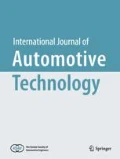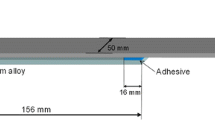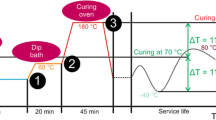Abstract
The aim of this study was to elaborate on the methods of constructing combined components of a car mirror. The components were made of materials with different thermal expansion coefficient. The basis for the research were numerical simulations prepared in Moldex 3D software. The external cover of a mirror would be made of carbon composite based on epoxy resin (hereafter referred to as carbon), and the internal insert would be made of ABS. The adhesive bonding applied did not provide appropriate properties and led to breaks during usage. After carrying out moldflows it was found that the areas of breaks were determined by the places where fronts of flowing material met during the injection. The cause of breaking was diametrically different thermal expansion of both materials. This induced significant stresses in the adhesive layer. Finally, the effective solution was to change the geometry of the mirror insert made of thermoplastic ABS.
Similar content being viewed by others
References
Bernaciak, M. (2012). Bonding composites. Design and Engineering, 11, 3–6.
Bociąga, E. and Jaruga, T. (2009). Weld line formation in the parts from multicavity injection mold. Polymers 54, 9, 654–661.
Campbell Jr., F. C. (2011). Manufacturing technology for aerospace structural materials. Elsevier Science. Amsterdam, Netherlands.
CoreTech System Co., Ltd. (2014). Mathematical Models and Assumptions. http://support.moldex3d.com.
Czulak, A. (2017). Composites in aviation - market analysis. Composites, 08.
Dziubiński, M., Kiljański, T. and Sęk, J. (2014). Theoretical basics and measuring methodology of rheology. Monograph of Technical University of Łódź. Łódź, Poland.
Frącza, W. (2012). The influence of polymers multiple processing on material parameters in the injection mould. Research of Rzeszow University of Technology, 284, 15–29.
Heneczkowski, M. (2016). Simulation of effect of injection parameters on moulded parts quality in autodesk moldflow insight. Mechanic 29, March, 252–255.
Kowalska, B. and Sikora, R. (2003). The effect of cooling time of the injection moulds on the thermodynamic equation of state. Polymers IIL, 5, 359–364.
Mayer, P. and Kaczmar, J. (2013). Properties and applications of carbon and glass fibers. Plastics and Chemistry 06, 52–56.
MICHAEL Teresa Michalik. (2017). Report on climate test.
MICHAEL Teresa Michalik. EDS Polska Sp. z o.o. (2017). Adhesive testing report.
Paszko, M. and Łygas, K. (2016). Actual methods of turbulent flow modeling in surrounding of a moving city bus. City buses: technology, utilisation, transport systems XVII, 12, 1269–1272.
Pramanik, A., Basak, A. K., Dong, Y., Sarker, P. K., Uddin, M. S., Littlefair, G., Dixit, A. R. and Chattopadhyaya, S. (2017). Joining of carbon fibre reinforced polymer (CFRP) composites and aluminium alloys-A review. Composites Part A: Applied Science and Manufacturing, 101, 1–29.
PSG GmbH (2015a). Defects of Moulds, Counter-measures Part 1. TS RAPORT spring, 74, 19–23.
PSG GmbH (2015b). Defects of Moulds, Counter-measures Part 2. TS RAPORT autumn, 75, 2–4.
Styrolution GmbH (2010). Product Information, Terluran HH-112 ABS. BASF SE
Zahorski, S. (1974). Viscoelastic flows in the inlet regions of tubes and plane channels. Theoretical and Applied Mechanics XII, 4, 561–576.
Acknowledgement
The research is financed from financial resources from the statutory subsidy of the Faculty of Mechanical Engineering, Silesian University of Technology in 2021. Authors would like to acknowledge: FX Carbonelements Sp. z o.o., EDS Poland Sp. z o.o., Paweł Paździor Work Project, MICHAEL Teresa Michalik and KUFIETA S.J. companies for sharing materials and providing content and technical-related supervision; special acknowledge for CoreTech System Co., LTD., producer of Moldex3D software and Biuro konstrukcyjne PawForm company for sharing educational license and for help with software.
Author information
Authors and Affiliations
Corresponding author
Additional information
Publisher’s Note Springer Nature remains neutral with regard to jurisdictional claims in published maps and institutional affiliations.
Rights and permissions
About this article
Cite this article
Paździor, P., Szczepanik, M. Solving of Thermoplastic-Carbon Bonding Issue Using Numerical Simulations. Int.J Automot. Technol. 22, 519–527 (2021). https://doi.org/10.1007/s12239-021-0048-9
Received:
Revised:
Accepted:
Published:
Issue Date:
DOI: https://doi.org/10.1007/s12239-021-0048-9




